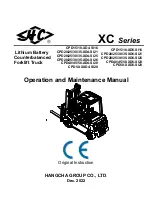
1 - 16
D - LAYING A HIGH LOAD ON TYRES
Do not lift the mast under any circumstances if the lift truck is not laterally horizontal
(See paragraph : F - LATERAL HORIZONTALITY OF THE LIFT TRUCK in the chapter :
INSTRUCTIONS FOR HANDLING A LOAD).
- Approach the load in the transport position in front of the pile (Fig. K).
- Lift the mast (1) until the load is above the pile, and move the lift truck forward (2) (Fig.
L) manoeuvring very gently and carefully (See paragraph : E - VISIBILITY in the
chapter : INSTRUCTIONS FOR MOVING THE LIFT TRUCK DURING HANDLING
OPERATIONS for visibility of the road). Apply the parking brake and place the
forward/reverse lever in neutral.
- Place the load in a horizontal position by tilting the mast forwards (1) and lay it down
on the pile (2) while checking the correct positioning of the load (Fig. M).
- To drive very gently and carefully.
- Free the forks by reversing the lift truck (3) (Fig. M) (See paragraph : E - VISIBILITY in
the chapter : INSTRUCTIONS FOR MOVING THE LIFT TRUCK DURING HANDLING
OPERATIONS for visibility of the road). Then bring the forks into the transport position.
E - TAKING UP A NON PALLETISED LOAD
- Tilt the carriage (1) forwards and move the lift truck forward (2) while simultaneously
crowding the carriage backwards to slip the forks under the load (Fig. N). If necessary,
wedge the load.
F - LATERAL HORIZONTALITY OF THE LIFT TRUCK
- The lift truck's lateral horizontality must be ascertained with the mast in low position.
- Apart from the transverse slope of the ground, several parameters can upset the
stability of the lift truck.
• The tyre pressure.
• The strength of the ground.
• The balance of the load.
• Strong wind or stormy conditions.
Before any handling operation, check the above points and make sure the lift truck is
laterally horizontal.
2
1
3
N
3
2
1
M
1
2
L
K
Содержание MC 40 Powershift
Страница 101: ...4 11...


































